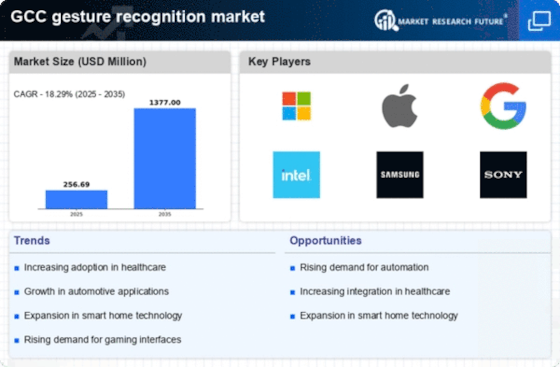Growth of the Gaming Industry
The gesture recognition market is significantly influenced by the growth of the gaming industry, particularly in the GCC region. With the gaming market projected to reach $1 billion by 2025, there is a growing interest in immersive gaming experiences that utilize gesture recognition technologies. These technologies allow players to interact with games in a more natural and engaging manner, enhancing overall gameplay. As gaming companies invest in innovative technologies to attract consumers, the gesture recognition market is likely to see substantial growth. Additionally, the rise of esports and competitive gaming events in the GCC is expected to further drive demand for advanced gesture recognition systems, as players seek to improve their performance through more intuitive controls. This trend indicates a promising future for the gesture recognition market as it aligns with the evolving preferences of gamers.
Technological Advancements in AI
The gesture recognition market is experiencing a surge due to rapid advancements in artificial intelligence (AI) technologies. AI algorithms are becoming increasingly sophisticated, enabling more accurate and responsive gesture recognition systems. This is particularly relevant in the GCC region, where investments in AI are projected to reach $20 billion by 2030. The integration of AI with gesture recognition enhances user experience across various applications, including gaming, virtual reality, and smart home devices. As consumers demand more intuitive interfaces, the gesture recognition market is likely to expand significantly, driven by these technological innovations. Furthermore, the growing emphasis on automation in industries such as retail and hospitality is expected to further propel the adoption of gesture recognition technologies, making them a vital component of the evolving digital landscape.
Expansion of Smart Home Technologies
The gesture recognition market is benefiting from the rapid expansion of smart home technologies in the GCC region. As consumers increasingly adopt smart devices, the demand for intuitive control methods is rising. Gesture recognition offers a seamless way to interact with various smart home systems, from lighting to security. The smart home market in the GCC is projected to grow at a CAGR of 25% over the next five years, indicating a robust opportunity for gesture recognition technologies. This growth is driven by consumer preferences for convenience and automation, as well as the increasing availability of affordable smart devices. As manufacturers integrate gesture recognition capabilities into their products, the gesture recognition market is likely to see enhanced adoption rates, making it a key player in the smart home ecosystem.
Rising Demand for Contactless Interfaces
The gesture recognition market is experiencing increased demand for contactless interfaces, particularly due to heightened awareness regarding hygiene and safety. In the GCC region, where public health is a priority, businesses are increasingly adopting gesture recognition technologies to minimize physical contact. This trend is evident in sectors such as retail, where touchless payment systems are gaining traction. According to recent estimates, the market for contactless payment solutions in the GCC is expected to grow at a CAGR of 15% over the next five years. As consumers become more accustomed to using gesture-based controls in public spaces, the gesture recognition market is likely to benefit from this shift towards safer, more hygienic interaction methods. This demand is further supported by the increasing integration of gesture recognition in consumer electronics, enhancing user convenience and engagement.
Increased Investment in AR and VR Technologies
The gesture recognition market is poised for growth due to increased investment in augmented reality (AR) and virtual reality (VR) technologies within the GCC region. As businesses and consumers alike seek immersive experiences, the demand for gesture recognition systems that facilitate natural interactions in AR and VR environments is rising. The AR and VR market in the GCC is expected to reach $1.5 billion by 2026, creating a fertile ground for gesture recognition applications. This trend is particularly relevant in sectors such as education, training, and entertainment, where immersive experiences are becoming essential. As companies invest in developing AR and VR solutions, the gesture recognition market is likely to expand, driven by the need for intuitive user interfaces that enhance engagement and interactivity.

















Leave a Comment